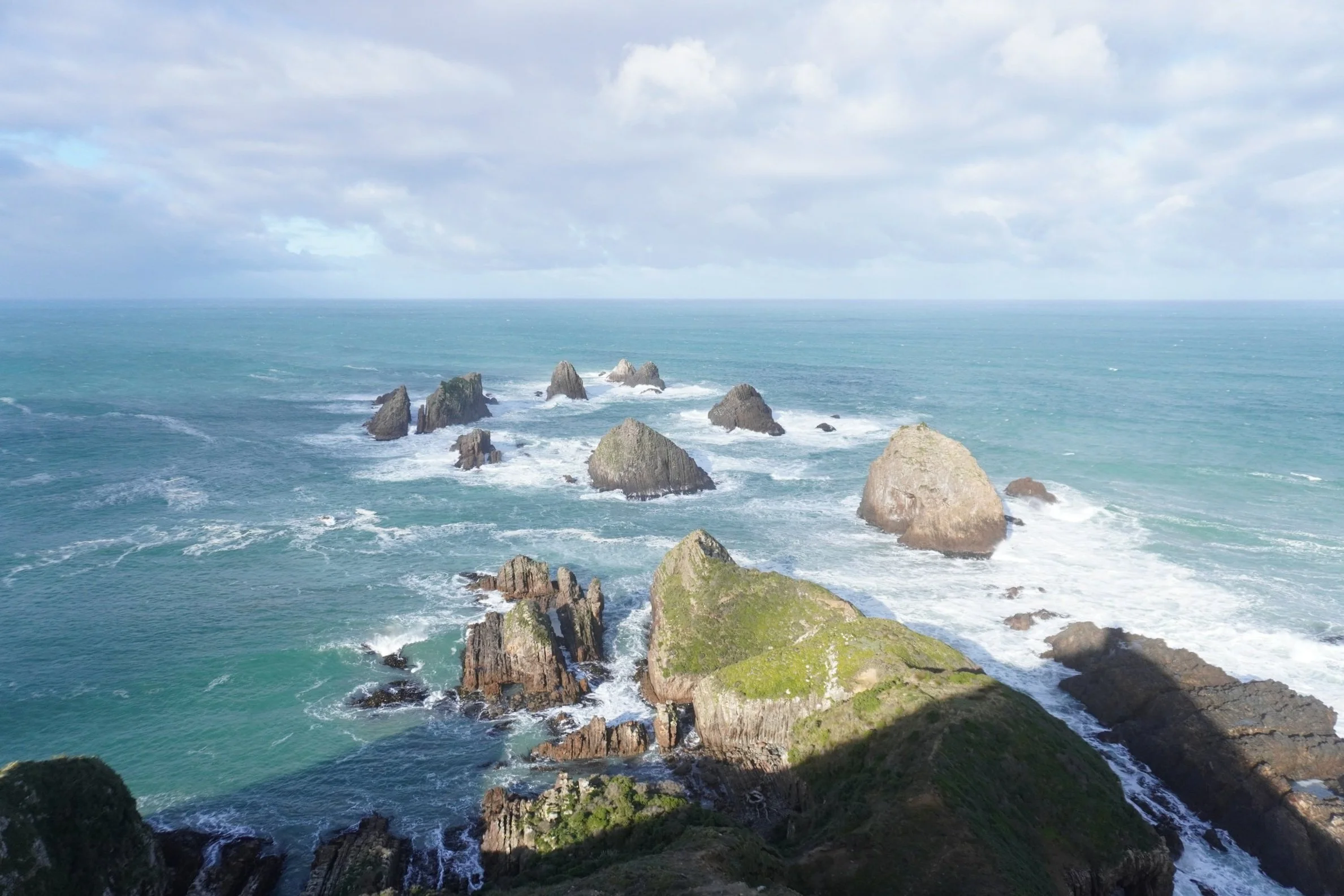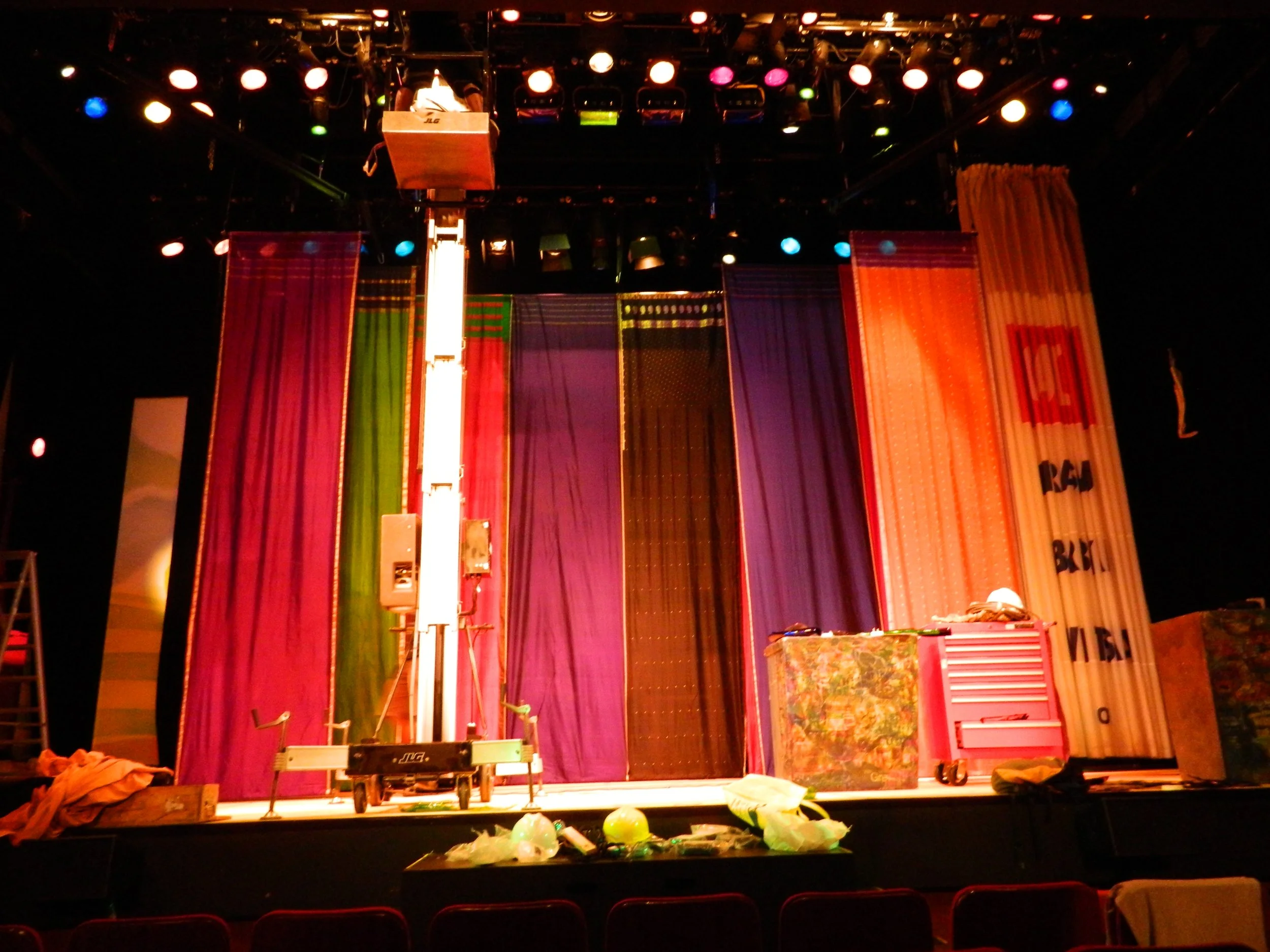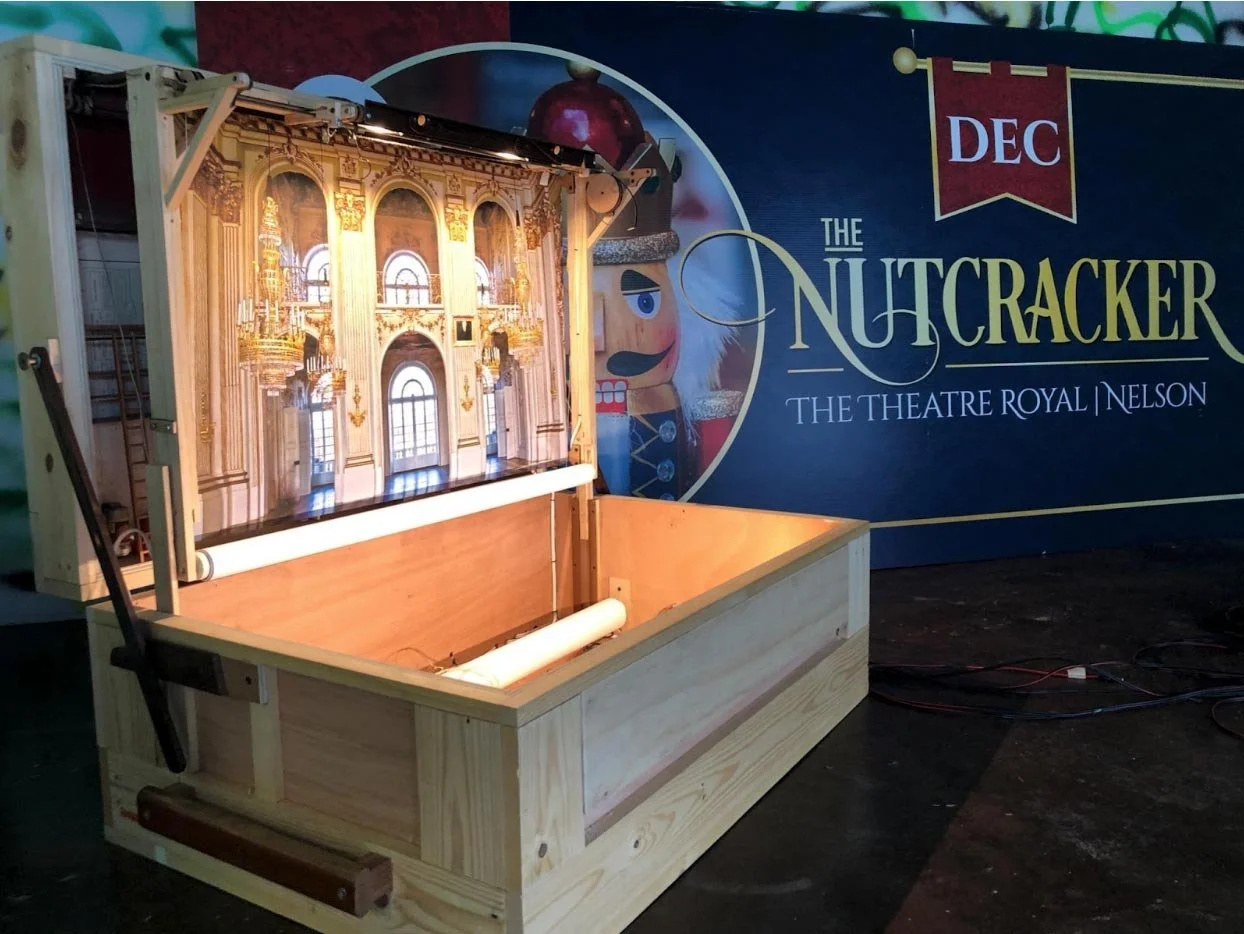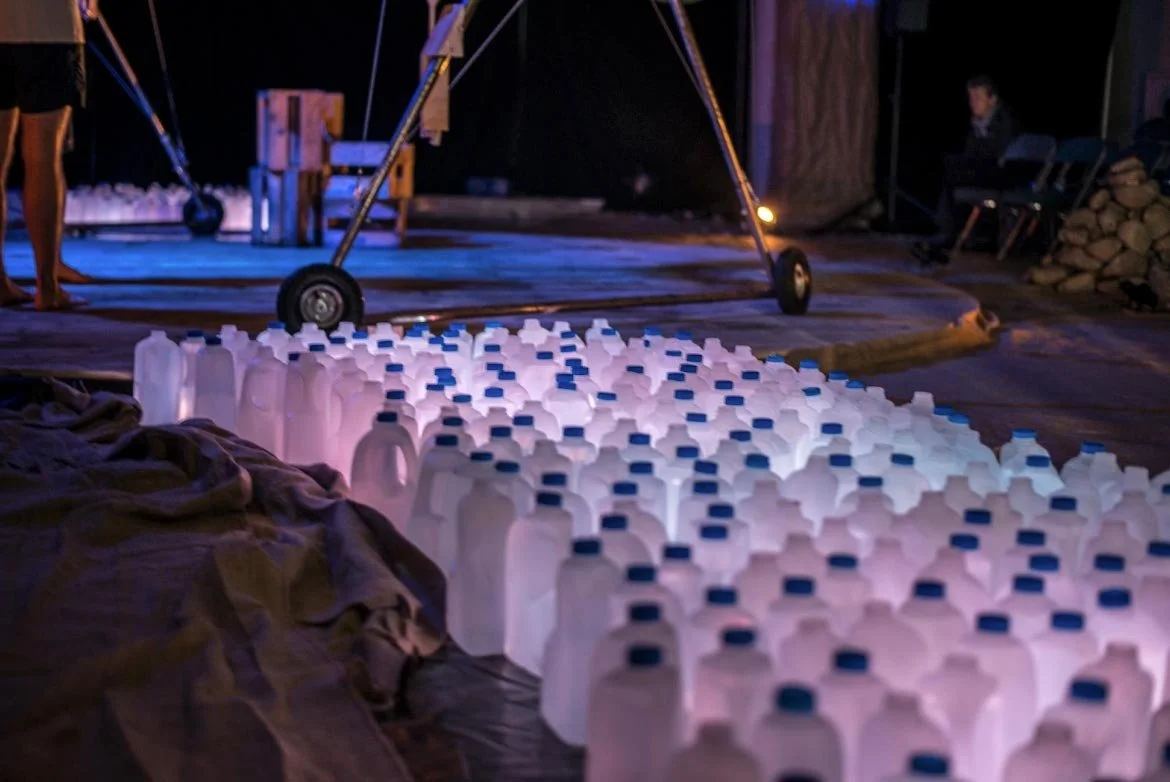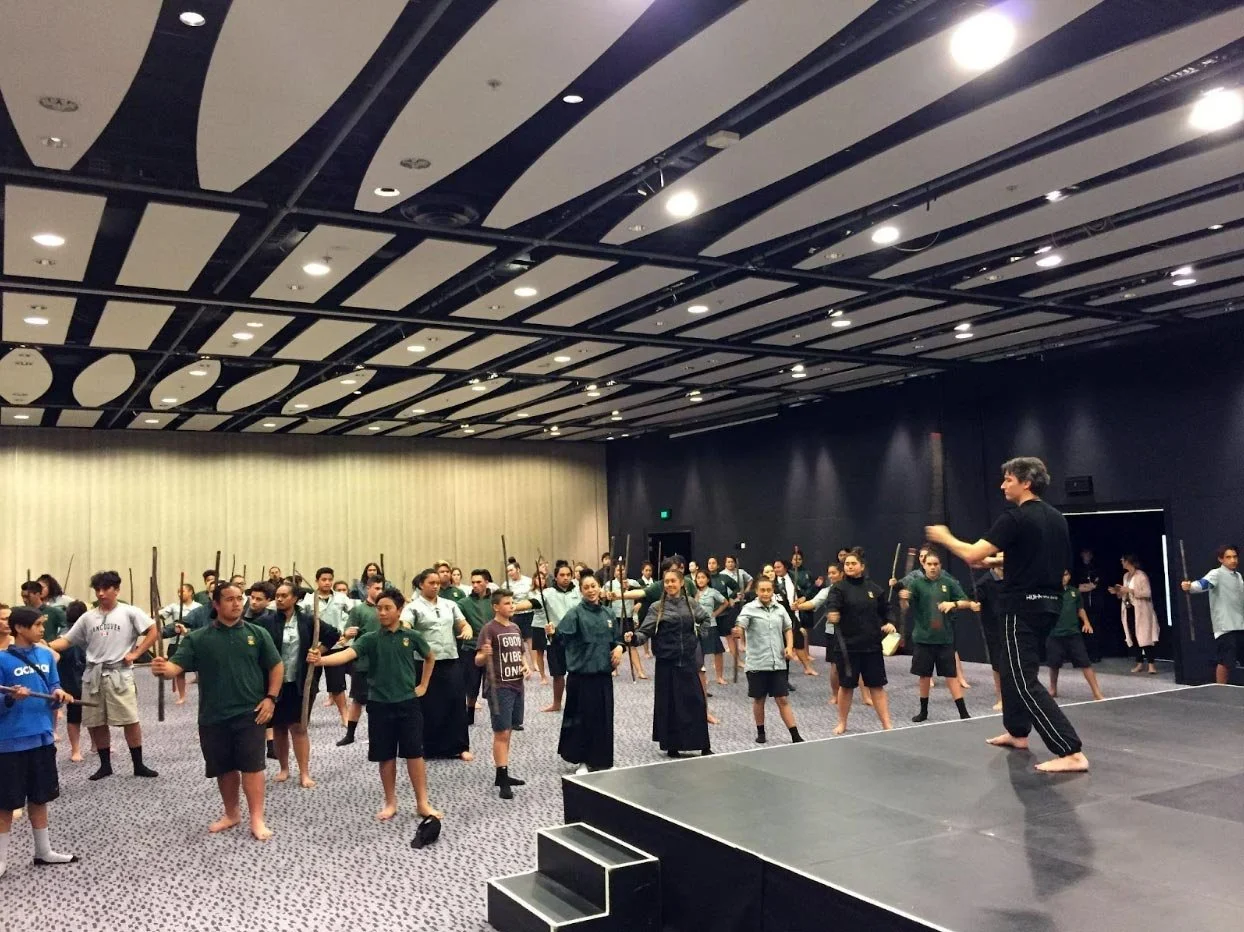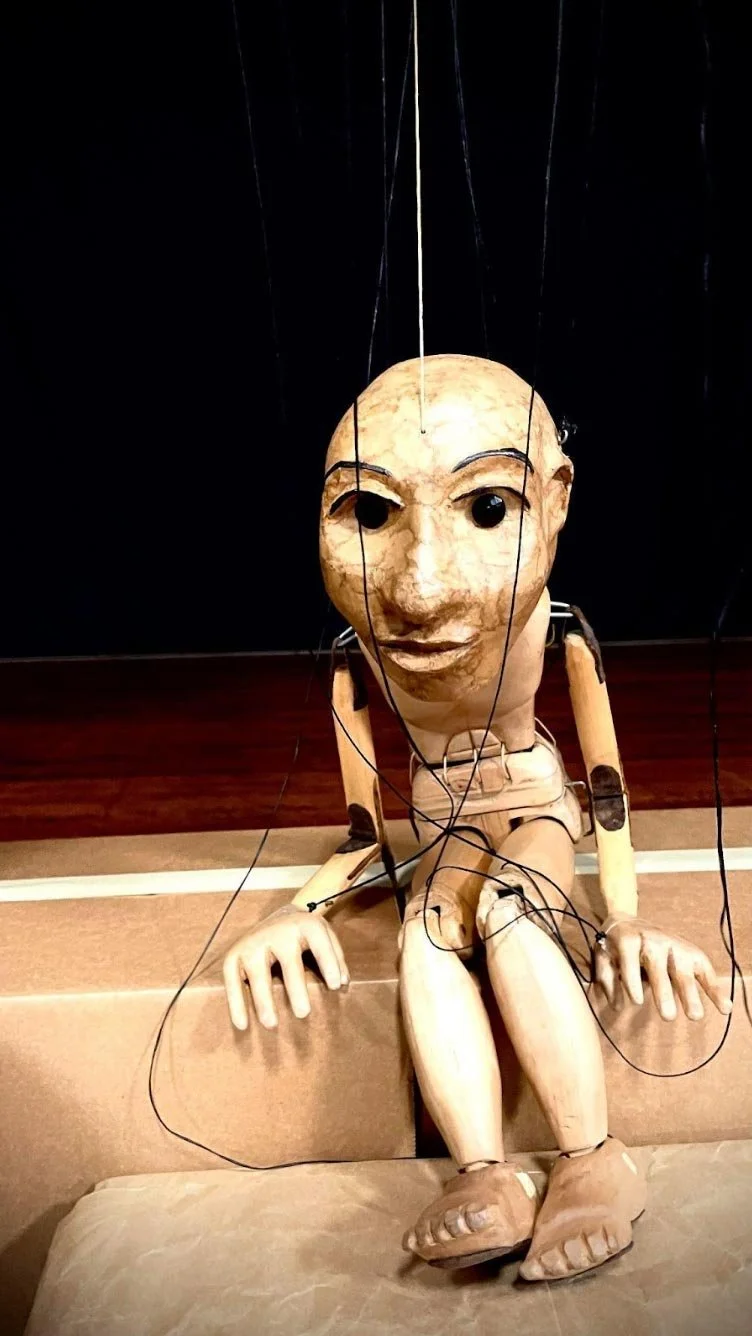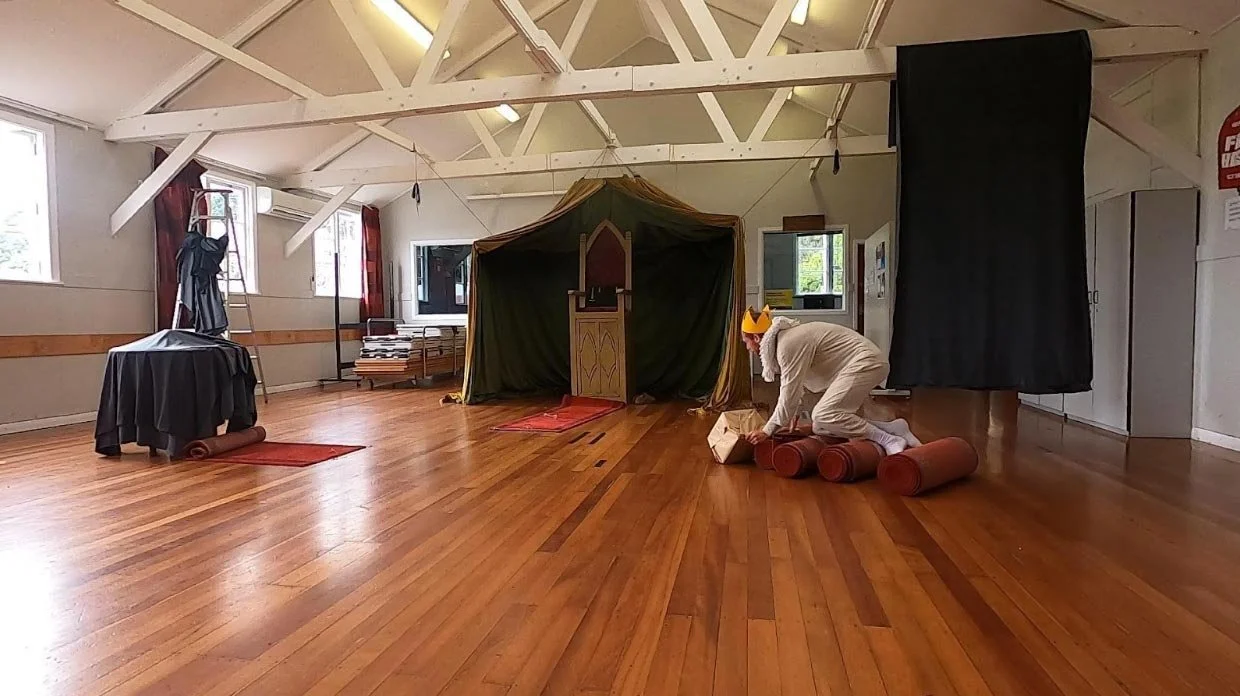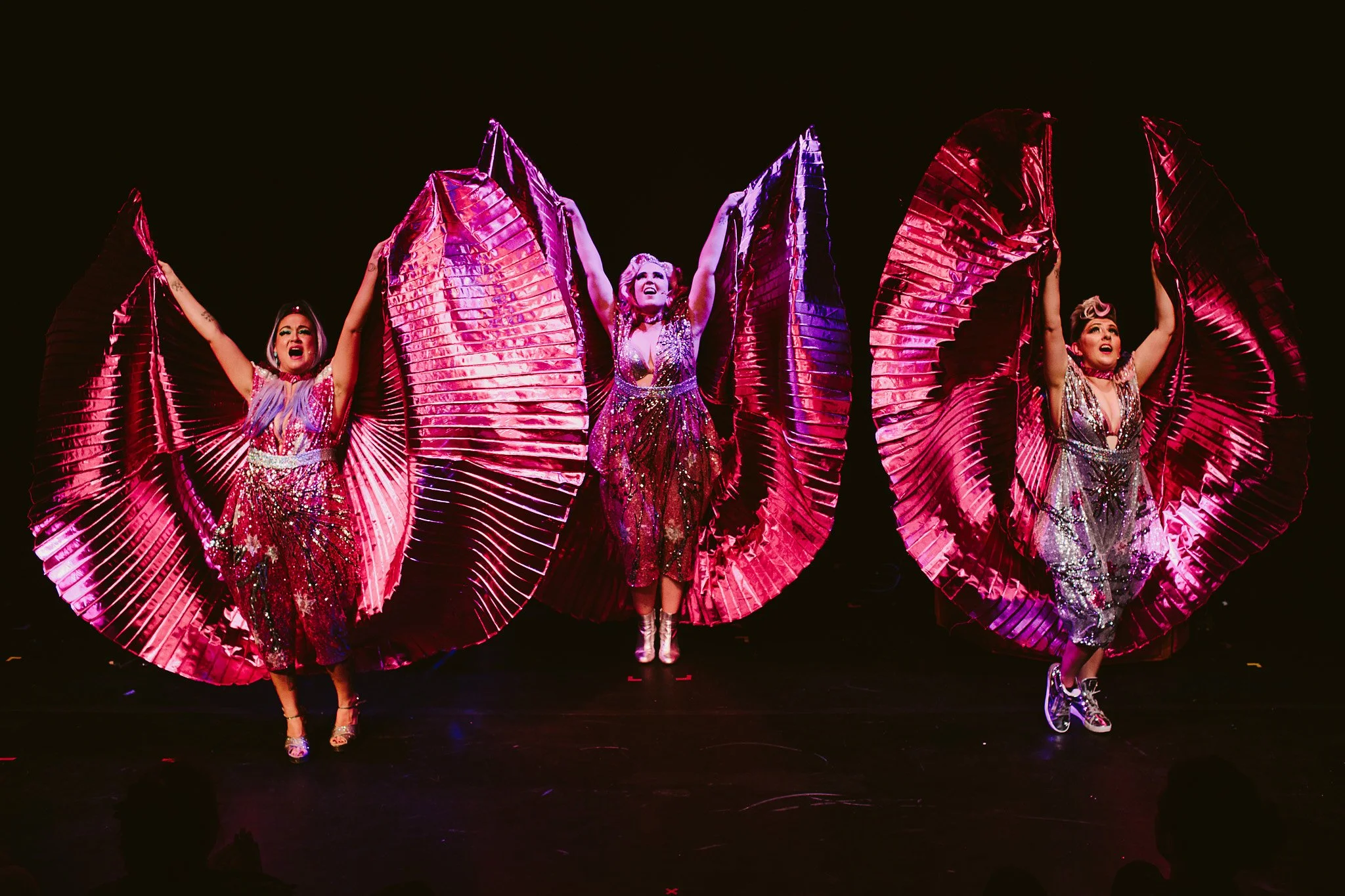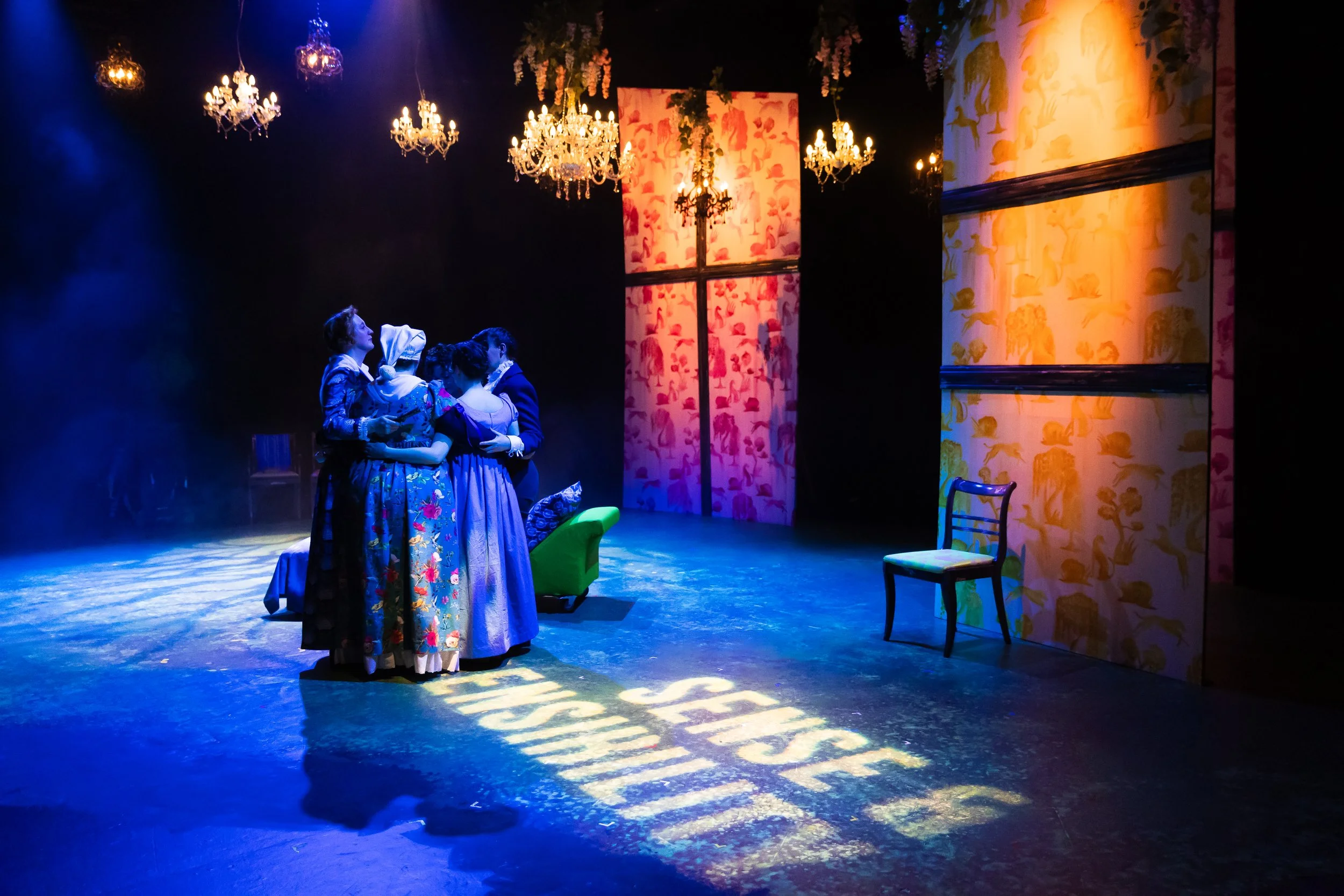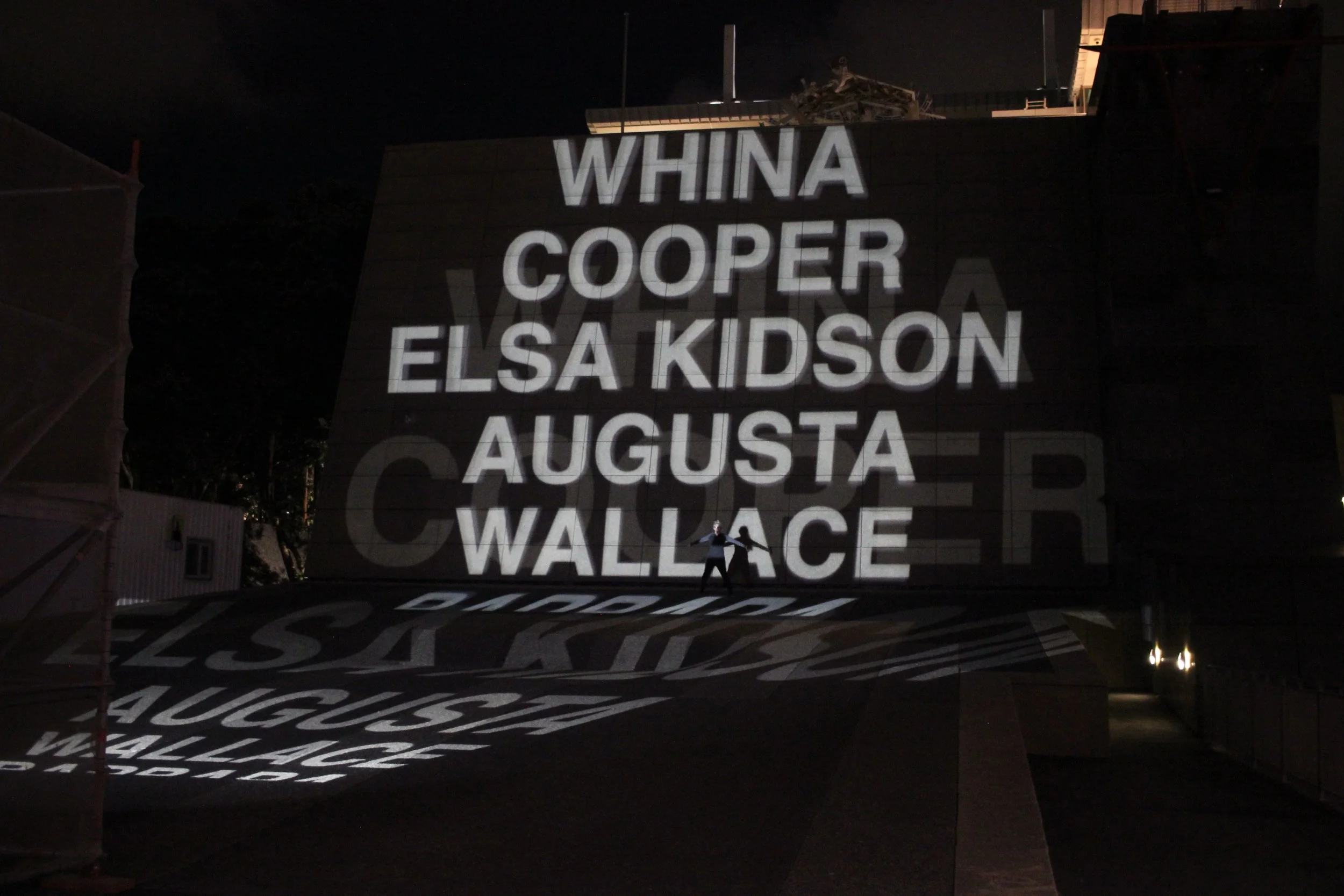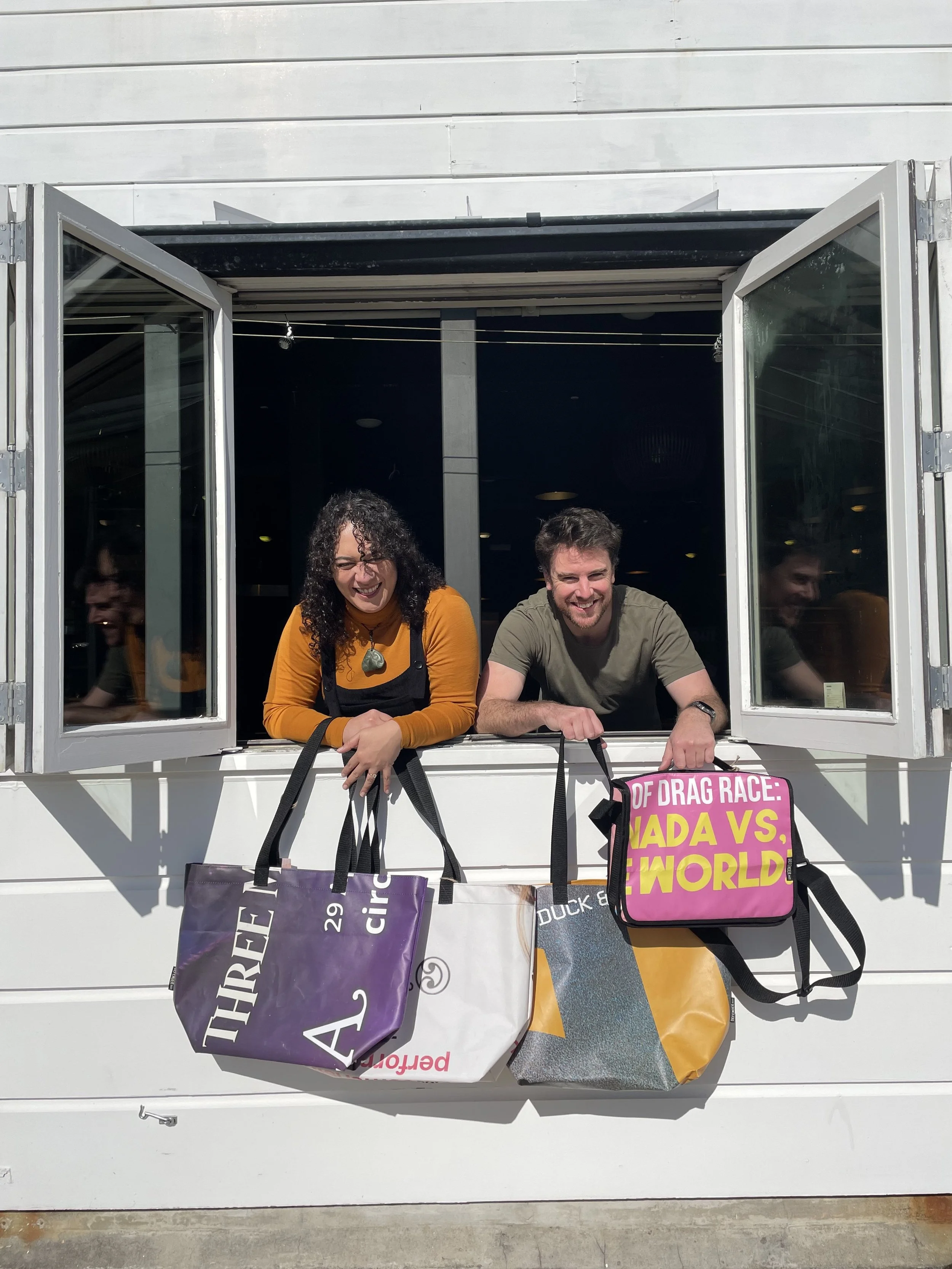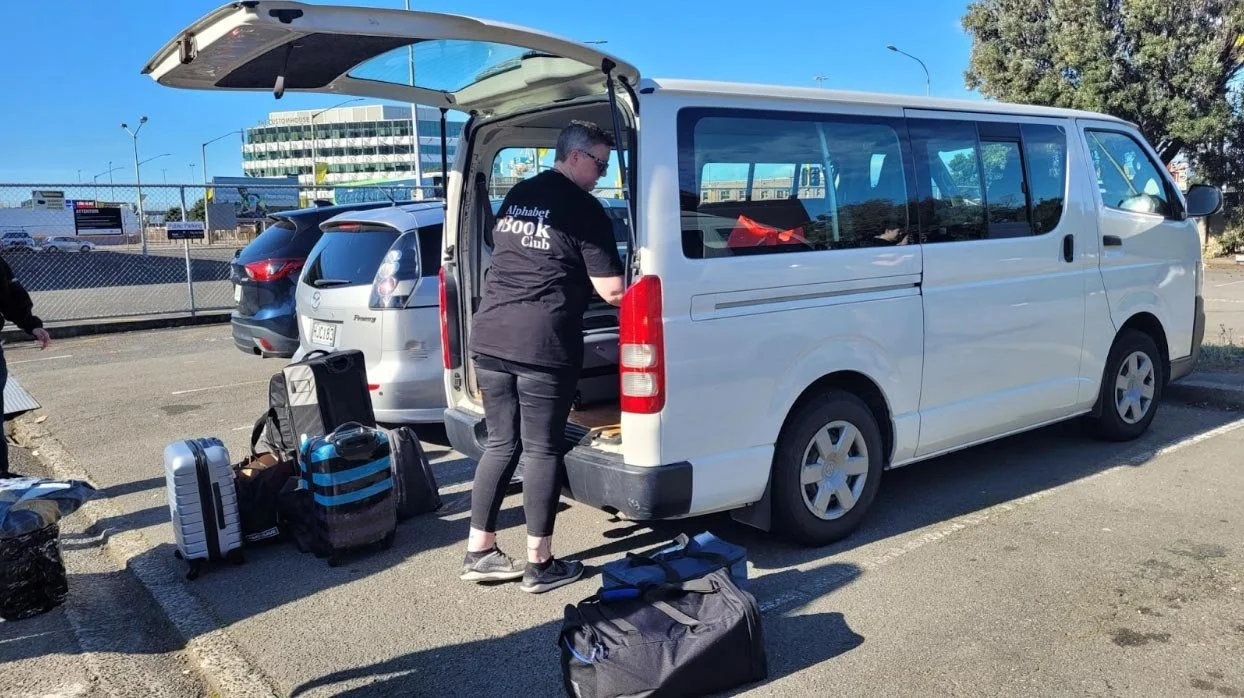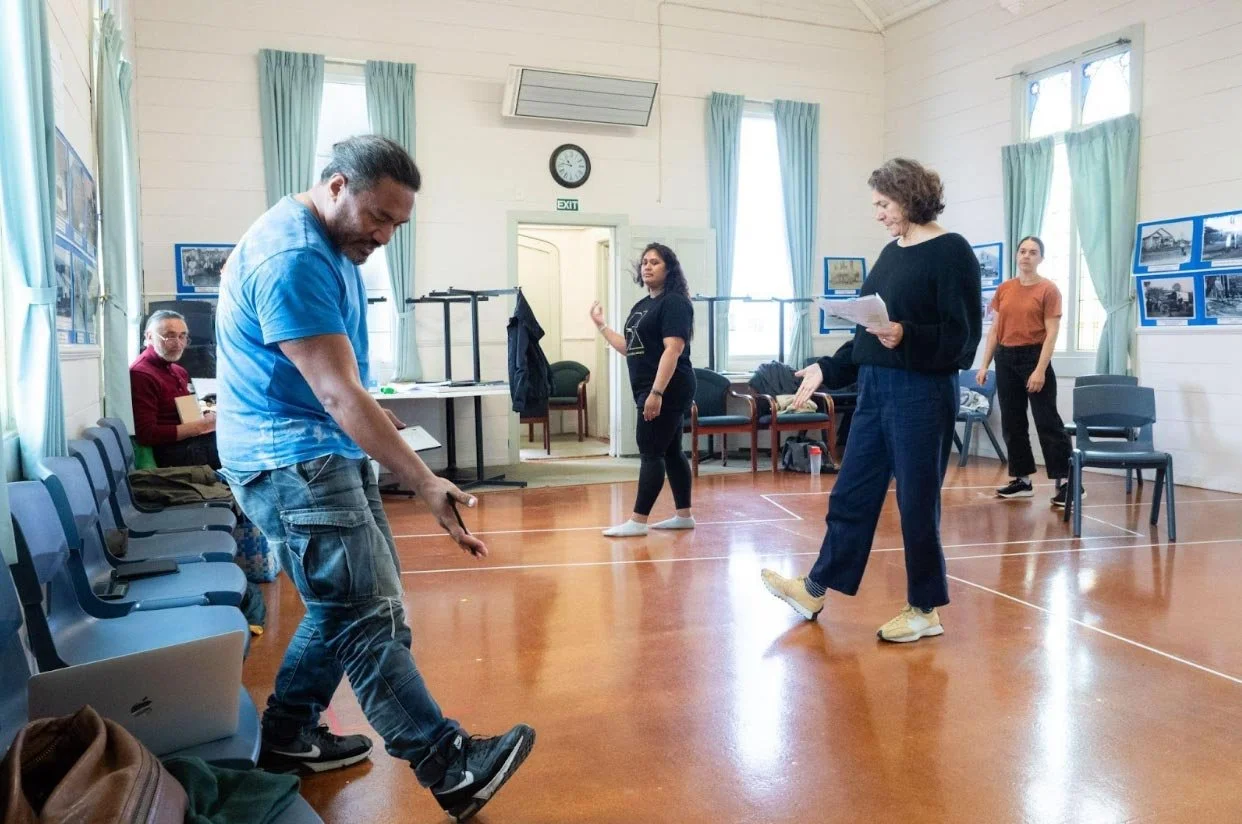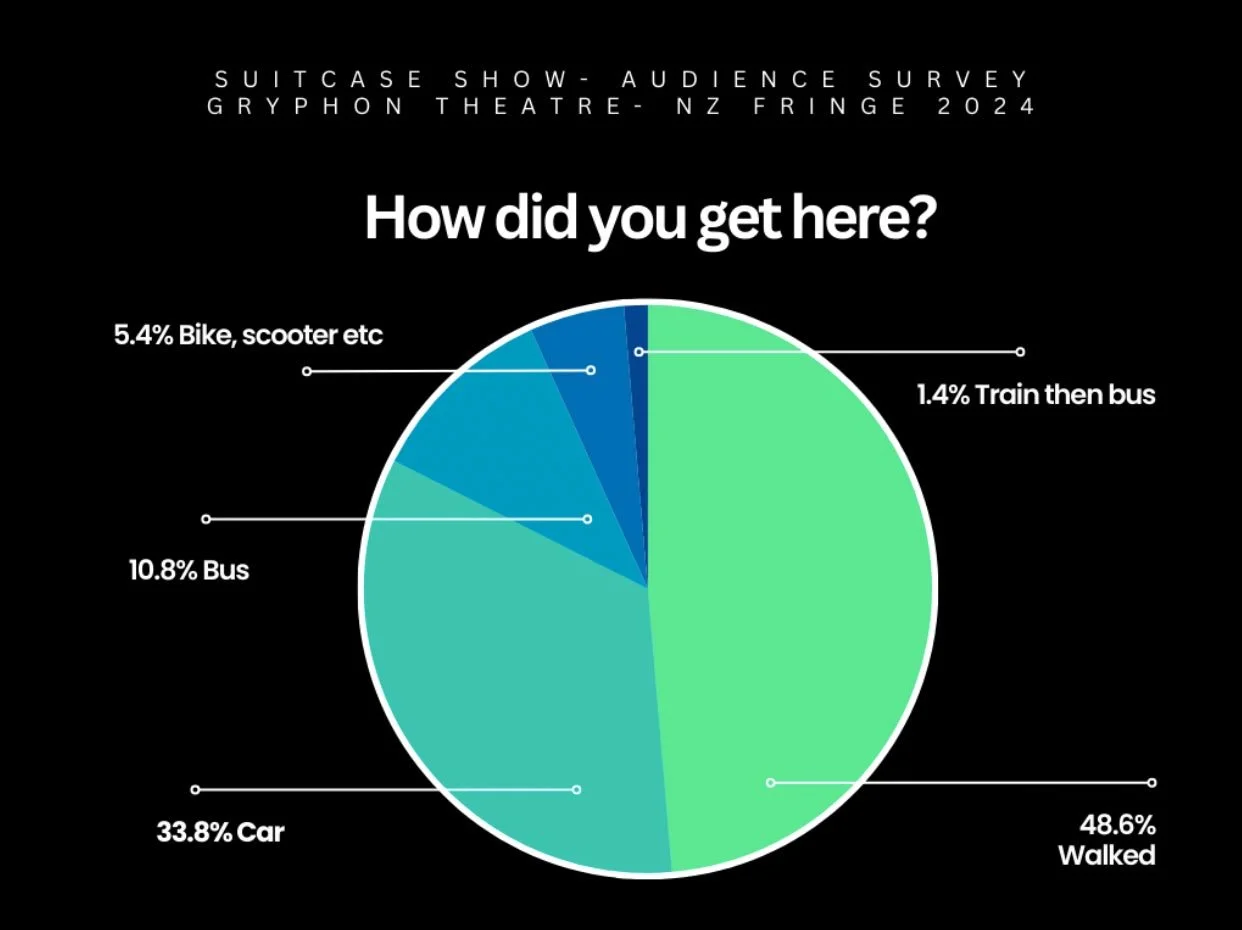
Pre-Tour
The most important work you’ll do to make your touring greener will happen before you set off. There’s mahi to do once you’re out on the road and after the tour has wrapped up, but the pre-tour planning stage is where you’ll set the wheels in motion, and where you can really cut emissions.
This chapter works through different aspects of pre-tour planning, looking at ways to minimise your environmental footprint. Whether you’re adapting an existing work, or making something to tour from the outset, the emphasis is to remove and redesign – that way you’re less reliant on offsetting post-tour (which is always the last resort).
Building your team
Look – you’re going to want to work with the people you want to work with, but if you can find collaborators who are based where you’re making the show, it will considerably lower your footprint (as well as your budget). If you do need to bring people in from out of town, try to consolidate these trips to avoid multiple journeys (particularly flights), and do what you can online.
With a commitment statement, you’ll know what you’re aiming for as a company. The next thing is to pass this on to those directly involved in your tour. It’s essential you do this up front, particularly with designers who do their main work early on. Green measures brought in after the fact are going to seem restrictive, but if people are aware from the get-go, these will form part of the kaupapa and can inspire ideas. Here are some ways you might communicate with your team:
Add green clauses to your contracts (in the same way you set expectations around health and safety, attendance, etc), but recognise that people often skim-read contracts, so flag environmental considerations as a priority in initial conversations as well.
Have a dedicated sustainability meeting with the whole team at the concept stage, then make it a standing item on all production meeting agendas. As Sustainable Theatres Australia suggests, “Get each department to share their goals, progress, and obstacles to encourage collaborative problem-solving.”
Decide on some specific goals around material usage and consumption for the production, e.g. Theatre Green Book’s baseline standard requirements: “50% of materials used in the production have had a previous life, 65% materials are stored or reused to have future lives.”
There are alternative approaches to setting these goals (see Sustainable Theatres Australia’s guides) – the key thing is to set things you can measure. Talk through how you’ll track these (see Materials Inventory), and brainstorm strategies to help reach these goals.Appoint a sustainability officer from within your team to run a Materials Inventory, coordinate the Data Collection Sheet, and to help and encourage green practice on the tour (though not to carry it alone). This should be someone going on the road – production managers and stage managers are well-placed for this. You can find a role description here.
It’s important to remember that while sustainability doesn’t always take more time, it almost always means your time will need to be structured differently.
Designers need time early on to work through creative solutions and source things second-hand, and you need time to introduce systems such as materials inventories.
This might mean that your budget gets spent in different ways – you’ll save money on materials by sourcing second-hand, but you might need to pay people for more time to find them.
Setting Expectations
-
As a company, we are committed to adapting our work and ways of working to be environmentally sustainable. To this end, it is expected that you:
take reasonable steps to minimise the environmental impact of your role and that of the company;
familiarise yourself with the company’s green policies, and participate in any further training or education necessary to work sustainably
bring to the attention of the company any practices that could be improved in relation to environmental performance.¹
¹This draws upon contract clauses used by Sydney Theatre Company. Sustainable Theatre: Theory, Context, Practice by Iphigenia Taxopoulou.
Photo Credit: Fié Neo
Te Wao Nui a Tāne
Ki uta tārei ai, ki tai rewa ai
Prepared onshore to sail at sea
Lasting action depends on the mahi you put in before you get going. The legend of Rātā tells of a chief who went looking for a tōtara to carve into a waka. Finding the perfect tree, he cut it down and set to work, but when he returned the next day, he found it upright and growing again. He felled it again, but the same thing occurred, and again on the following day. After that time he hid and watched as te tini o hakuturi (the forest guardians) resurrected the tree to grow in its original place. When confronted, they reminded him he’d failed to perform a karakia for Tānemahuta. Once he did this, the hakuturi helped him to build a waka better than he could have built alone.
Get the preparatory work right the first time, and not only will the work be easier, but you’re more likely to find the community will get in behind and support you.
Environmentally conscious design choices will reduce your materials and waste, and likely cut your emissions (and costs). We’re not suggesting every show should be a one-person mime piece – sometimes your vision is big, and sometimes spectacle needs stuff. Instead it’s about being mindful and making sure everything’s earning its keep: working smarter to cut back unnecessary waste and weight.
Materials Inventory
Materials inventories are tools to track the materials used in your show. They make it easier to get a snapshot of where things are coming from, and to make a plan for where they go after your run.
A good example is The Theatre Green Book Materials Inventory, which allows you to calculate the percentage of material that has had a previous life, and that will be reused or recycled afterwards. For a Baseline level production, it suggests you aim for 50% of materials you bring in to have had a previous life and 65% of materials to be reused or recycled afterwards.
A good thing about running a materials inventory is that you can also use it to make a plan for the end of the show. Add in each material at the time it comes into the room (it’s much harder to do it all afterwards) and record your anticipated disposal method then (storing, donating, recycling). This info can then be used at your last pack-out so you can separate materials and streamline the time you spend figuring out where things are going, when you just want to head to the bar / to bed. You might also draw on this inventory if you’re creating a packing list for the tour, or a carnet to send freight.
Creating a materials inventory shouldn't mean a lot of extra work – you will likely be tracking things coming in anyway in your budget/props list.
Set Design
Design
Highlight environmental considerations in your design brief (just as you’d outline budget, looks, and staging demands). You could set specific sourcing requirements and limits on materials (e.g. the Theatre Green Book’s baseline standard).
Start your process by taking stock of what’s available and local. Look at what you’ve got in storage. Take a trip to the Tip Shop. Check out what’s on offer in Facebook Zero-Waste groups. You might find a treasure trove of free materials that can inspire ideas and reduce costs.
Think laterally. The first choice isn't always the best choice. Can you do more with less?
Design a durable, flexible set that can adapt to different venues. Factor in transportation, and reduce what’s not essential. Consider:
How will things pack down?
What can be packed inside of what?
What things can do double duty?
Are there generic elements (like rostra) that might be picked up on location to reduce your weight or mean a smaller vehicle on the road?
“The more lead-in we have, the better choices we will make. If there is time pressure our default is to buy the first option that fits, and this means we never consider whether the product could be sourced more ethically, or even found second hand within the community.”
– Lee Woodman, set designer
Read the full article here.
Krishnan’s Dairy Pack in 2012, Courtesy of Indian Ink Theatre Company
The Nutcracker by Theatre Royal Nelson and Primarily Dance. Designer Lee Woodman built a miniature set in a box, with a live feed to a projector which fed the full size to the backdrop. Photo: Lee Woodman.
Thinking Laterally
In 2013, we produced a show called Broken River – a work with overt environmental concerns, about a rural community divided by a proposed irrigation scheme that would transform the landscape: on one side was the river, which would be greatly damaged if the proposal went ahead; on the other side, the prosperity promised by dairy’s greener pastures. It was performed in a vacant retail space, and the set centred on a kinetic water sculpture designed by Chris Reddington – a nightmare vision of an irrigator, that rained down water on the actors through the show (to be reused through the course of the season).
Trick of the Light Theatre’s Broken River. Photo: Anita Pitu
Until very late in the game, we intended to pump this water into a miniature braided river that ran beneath the audience’s feet. The vision was ambitious, but it would have required power for the pump and a significant amount of single-use plastic sheeting to contain the water. As time and budget slipped through our fingers, we abandoned this plan for something less literal: hundreds of 2-litre plastic milk bottles laid out in the shape of a river to represent 1000 L of fresh water — at the time a (conservative) estimate of how much water went into producing a litre of milk. The river was lit from underneath by repurposed LED strip from a previous production, and the milk bottles were sourced with alarming efficiency from cafes within walking distance.
It was a design decision driven by necessity, but as well as being more sustainably sourced, in hindsight it was hugely more effective in expressing the show’s themes.
Ralph McCubbin Howell – writer / director of Broken River
Trick of the Light Theatre’s Broken River. Photo: Urban Dream Brokerage
Iterative Process
Shows will evolve through the course of rehearsals. Many evolve again after a season, or between tours, which means design elements need to be changed. Sometimes you just need the thing to rehearse the bit, but where possible, it can be less wasteful to hold off acquiring things till you really know what they should be. Is there a stand-in that will do the job? And if you know a design element will have to be tailored, can you draft out of material you can recycle or compost?
Tānemahuta Gray works this way when teaching mau rākau workshops, by making staffs from kōrari (flax stems). “They’re lighter, softer, and less dangerous for first-timers to practise. When the longer ones get snapped, they can make shorter ones for kids, and when the pieces are too short for anyone, they go back to the plant to replenish the soil.”
Tānemahuta Gray teaching students taiaha choreography using kōrari. Photo: Taki Rua.
This mindset is also good when you’re figuring out how you’ll tour materials. Flight cases are great, but they’re a big investment, and when you’re making a new show, you don’t always know what you’re going to need them to hold. Use cardboard boxes the first time you transport it across town – it will help you know what you need from a more durable flight case and save you having to remake or rebuy.
Tour Efficient Set Design
“I love good engineering. Some elegant design solutions may never be appreciated by the audience, but will be relished by those who built it, perform on it, pack it down, load it into a van, and lug it around the airport. It’s a particular type of satisfaction that comes from knowing you have squeezed every gram of utility out of each gram of CO2e from each thing you put in a bag and sent around the planet. Harnessing the inherent properties of the construction materials and maths to build weight-bearing structures that pack down into a ski bag not only ends up saving $$$, and CO2e, but is also an art in and of itself.”
Tim Watts, The Last Great Hunt
Construction
Make sure your set builders are on board with your goals, and deconstruction / reuse requirements by communicating with them as you did with your designer.
Make use of tool libraries (e.g. Newtown Tool Library, Auckland Library of Tools, or Tool Lendery in Ōtautahi). Refer to the Production Creation / Disposal Directory.
Touring is hard on sets. Talk to other companies who’ve toured in a similar way (e.g. a national tour in a van, an international tour) to find out what will hold up to freighting, flying, etc, and to avoid energy-expensive rebuilds and maintenance.
Design for disassembly. Bolts are the best fastenings, screws are okay, nails and glue are the worst. Use whole sheets of material such as ply where possible as standard sizes are easier to reuse. Read about designing for disassembly here.
Factor transportation into the design. If things can be packed flat or nest inside one another, it will reduce how much you need to freight, and potentially reduce the size of your vehicle.
Marionette puppet made of wood and papier mâché created by Ana Lorite. Photo: Naranjarte
Sourcing
Use existing materials wherever possible. Check out sharing hubs such as The Green Green Room in Te Whanganui-a-Tara, see if other companies have what you’re looking for, or try to buy second-hand. Think about which items will be harder to come by, and start looking for these earlier.
If you have to buy new, use certified materials from sustainable sources. Check out FSC’s Certified Directory for sustainable timber and look for paints that carry the Eco Choice Aotearoa label.
Whether reusing or buying new, source locally if possible to reduce carbon mileage.
Avoid harmful materials and any that can’t be recycled.
Don’t use polystyrene, don’t use polystyrene, don’t use polystyrene.
Most venues will ask you not to use glitter anyway, so save yourself a fight.
MDF is cheap but nasty.
Find further information about materials to use and avoid here.
“Sourcing used materials is easy in the beginning and harder towards the end of the creative process... Taking time to communicate to your working group that the project is environmentally conscientious has to be done right at the beginning, and be reiterated throughout.”
– Thom Monckton, visual and physical performance creator
Read the full article here.
King of Taking dress rehearsals at Strathmore Community Hall. Photo: Thom Monckton
Freighting Overseas
Taking a set overseas isn’t easy. It’s one thing if it’s a suitcase show, and you just need to fly an extra bag, but anything bigger presents some conundrums. Air freight is fast but expensive, and it comes with a large carbon footprint. Sea freight is greener and cheaper, but it’s longer and more unpredictable (think months not days or weeks). Either option comes with risks (your set could be damaged or held up in transit), plus importing and exporting comes with costs and a mountain of paperwork.
It might seem counterintuitive to replicate materials, but building a second set or sourcing bulky equipment locally might well result in lower emissions. You’ll need to plan and build time at the end of your tour to dispose of these things responsibly (don’t leave it until the last day). Start by approaching your last venue well ahead of time – they might buy or accept a donation of this equipment, direct you to local theatre companies, or at least point you in the direction of charity shops and local recycling facilities. You could also try Facebook for theatre exchange groups (e.g. Melbourne Theatre Recyclers) or general Zero-Waste groups, and look for production disposal directories like Sustainable Theatre Australia’s.
If you do need to freight things, try to minimise the journeys – do things need to return home or can they carry on to your next offshore tour? In terms of emissions, sea freight is better than air freight, rail is generally better than road. You can compare freighting journeys and their emissions through an app called SeaRoutes.
Touring set for Trick of the Light's The Griegol in the USA, with stage manager and co-designer Sylvie McCreanor. The packing cases did double duty as backstage props tables, and their dollies unclipped to be used onstage. Photo: Ralph McCubbin Howell
-
“Systems rule. We’ve always been pretty good at holding onto stuff after seasons. When we were starting out, this was a pile in the hallway, but even once we had secured a dedicated storage space (read: garage), for a long time we didn’t have a system to keep track of what was there. We’d find ourselves in the rehearsal room going ‘I’m sure we’ve got that specific HDMI cable somewhere,’ being unable to find it, and then running out to buy a new one because we didn’t have time for an archaeological dig. It was a dumb waste of money as well as materials.
We first tried to create a database in Google Sheets but found this had some limitations, so invested in a catalogue app (we use StuffKeeper, but there are others). We pay $25 each a year, it took a chunk of time to catalogue, and it’s only as good as its upkeep, but we have easily made that money back by being able to draw on materials we already own. It also means we can send someone else to our space and they are able to locate a particular thing.”
Hannah Smith, Trick of the Light
Aotearoa is a long way from everywhere. Avoid fast fashion where you can – it ships from overseas. Start with op shops and hiring costumes from companies nearby.
If new materials are required, confirm they are sustainably produced through Common Objective’s organisation database.
If new costumes are being made, think about their end of life – can they be reused in future productions, can they be sold (iconic merch!), or can they be donated to be reused by other companies or education facilities?
Consider how materials will hold up on tour, and what they’ll need in terms of laundering. Items that must be washed separately will use loads more energy, compared to bunging it all in together.
“Beyond focusing on using more sustainable materials, we must propose an entirely different system of understanding and valuing them: shifting mindset away from a quick means to an end, to the entire lifecycle of materials and their social, spiritual, emotional value will build towards long term sustainability.”
– Steven Junil Park, costume designer
Read his full article here.
Costume Design
Steven Junil Park’s costume designs for Scenes from a Yellow Peril. Photo: Andi Crown Photography
Fringe Wives Club Edinburgh. Photo: Kate Pardey Stage Shots
Stage Management
Packing shows in and out multiple times every week can mean you go through a lot of consumables. Think through systems in advance to reduce these to the minimum.
Upu rehearsal. Photo: Andrew Malmo
Go digital to minimise wasted paper. Encourage the use of digital scripts (either on tablets or laptops). If that’s not possible and your rehearsal script is still a work in progress, Sustainable Theatres Australia suggests you “print it with page breaks for every scene or act. That way, if major edits occur, the entire script does not have to be reprinted.”
Tape and cable ties are sometimes foods. Yes they’re wondrous things, they’ve saved many a show, but we use them way more than we need to, and they’re not always the best tools for the job.
For rehearsal stage mark-ups, use chalk, rope, or even objects like shoes. For spikes in performance, use chalk (or a chalk pen) – make sure you check with your venue tech first, but it comes off with water (or, failing that, unsettlingly well with some Coke).
Work with set designers to integrate cable management into the scenery. It’s important to avoid any trip hazards, but a lot of the time we overkill when it comes to gaffing down cables. Use cable trays anywhere out of sight.
Use Velcro strips or reusable cable ties when coiling cables, rather than lecky tape. If you attach one to the cable, it’s always there when you need it for each pack-out.
Don’t laminate that. Seriously. Unless it’s going to be used with a whiteboard marker, or directly exposed to moisture AND you need it to last for a really long time, don’t laminate that. Rehearsal schedule? Don’t laminate that. Dressing room door sign? Don’t laminate that. Sign in the kitchen or outside a flight case? If you must, knock yourself out.
Treat plastic like a taonga. Plastic deservedly gets a bad rap – it builds up in the environment, it breaks down into microplastics in our food chain, and it’s made from petrochemicals – but the reason we use it so much is that it does some things very well. It’s lightweight, moisture proof, and strong. The problem is single-use plastic. If plastic comes into your process, use and reuse it for as long as you possibly can (then recycle it).
Use rechargeable batteries or USB-chargeable devices.
Mic packs burn through batteries. Check if your venue uses reusables, and if they don’t, let them know you plan to bring your own. You’ll need to invest in a smart charger system and create a routine for charging at the end of each performance.
If you’re flying, you’ll need to take the batteries in your carry-on in such a way that the battery ends won’t touch. You can tape over these, but an easier, more sustainable way is to buy battery cases so you can use them multiple times.
Work with your designer to create an energy-efficient and flexible lighting design.
Consider building an energy-use cap into your design brief – calculate the number of instruments and per hour wattage you plan to use, and set this as a limit. If you want to bring in more instruments, stick to this limit by having others do double duty, or switching to more energy-efficient fixtures.
Assess the specs of the venues you’re touring to. Do you need to travel with your own lighting desk? Using a laptop-based console such as an ETC nomad will make things easier and reduce your freight.
Work towards a lighting design that can utilise standard rigs and avoid freighting extra equipment. Where you do have to hire, use local suppliers with environmental policies.
Use pre-vis software to test your designs in different spaces before you start switching on lights.
Create two show files to accommodate venues with LED (light emitting diode) lighting fixtures and those without.
If you tour with your own lighting instruments, choose LED lamps (and use the smallest instrument that will do the job to reduce freight).
Encourage the venues you visit to switch to LED lamps if they haven’t already, and retire those power / lamp / gel-hungry lights. Gels are imported single-use plastic, with an estimated lifespan of 1000 years, and need to be replaced surprisingly quickly (another great reason for venues to switch to LED).
BUT bear in mind that whilst LED is undoubtedly preferable in terms of energy savings, for tours of less than two weeks, your emissions footprint may be lower by using existing, potentially less energy-efficient fixtures, than it will be to hire and transport equipment from out of town.
If you’re touring overseas, remember that other countries use different plugs, and some (like North America) run on different voltage. If you have to tour your own equipment, take universal plug adapters and power converters to avoid buying additional stuff once you’re there.
Lighting design
Sense and Sensibility, lighting design by Marcus McShane. Photo: Roc Photography
“Good touring lighting design should be flexible enough to take into account a broad range of variables. This behoves simplicity, which fortunately goes hand-in-hand with sustainability. And there are also some small but very significant things you can do to reduce the emissions and waste you create as you tour.”
– Marcus McShane, Lighting Designer
Read more about green lighting design here.
-
Lighting is one of the highest contributors to emissions over the life of a show. Energy-efficient lighting design will make a difference, but switching instruments to LED fixtures is what will really reduce this footprint. In terms of light output, an LED fixture is ten times more energy efficient than a conventional bulb, and one instrument can do multiple colours so it will likely save you money (and eliminate gel cuts and changes!).
But switching to LED is an investment, and you want to think it through rather than rushing into it and buying the wrong thing. If you own and tour with older equipment, and are keen to make the switch, consider the following:
Converting to LED fixtures is the fastest way forward, with the greatest impact on energy savings.
LED fixtures come with an upfront cost, but as they require fewer lights to fill a lighting grid, they create ongoing power savings and will pay for themselves in a few years.
You can stagger this transition, replacing outdated fittings carefully and proactively. (This means lighting designers will need to work with evolving equipment lists and potentially a variety of fixtures.)
Venues that have been built or upgraded since 1980 should have the capacity to use LED fixtures.
New dimmer technologies can reduce energy usage further by allowing remote monitoring and automated shut-downs.
The Impossible Has Already Happened, choreographed by Claire O’Neil and Jennifer Mascall. Lighting and set design by Marcus McShane. Photo: Stephen A'Court
Projection design
Investigate using in-house projectors to reduce your freight, but bear in mind this means that you’ll encounter various models in various states, that venues may charge you to use them, and that they won’t want you to move or refocus them. As an alternative, you could hire the same model locally at each stop on your tour. If you are touring your own, minimise the kit that goes with it. Do you need that heavy SDI cable, or do they have this at the venue?
If you can afford it, use a laser projector. They’re more expensive initially, but cheaper in the long run. They require no lamp changes, are more power efficient, last much longer, produce brighter and higher-quality images, and are far less polluting than lamp-based projectors.
Traditional projector lamps contain hazardous material. Dispose of them correctly – in Aotearoa that means sending them to Interwaste, who have the only mercury recycling facility.
“[On the face of it, projectors are] a nightmare from a sustainability point of view. However, it doesn’t have to be this way. And, as with many things, the greener possibilities are also the more cost-effective ones.”
– Marcus McShane, projection designer
Read more about green projection design here.
Shoreward Surge by Marcus McShane. Photo supplied.
Marketing
Circa’s recycled billboard bags. Photo Credit: Anna Barker
Marketing Materials
Posters. Consider a digital marketing campaign (using social media, digital ads, and EDMs/email newsletters) – it’s generally cheaper and more targeted as a way of connecting with your audience. If you are printing, use a carbon-neutral printer or one that uses eco-friendly processes (e.g. 100% post-consumer recycled paper, vegetable-based inks, and alcohol-free printing processes).
Order realistic print runs, and print more only if necessary. Target your postering – 20 A3 posters that you put up yourself in locations you choose (cafes, libraries, etc) are likely to have more impact than 50 posters put up by others on crowded street poster bollards.
Billboards. If you are printing larger scale vinyl billboards, consider whether you can extend the life of this material beyond their use for publicity. Circa Theatre partner with Defender Bags to upcycle their billboards into bags they sell as merch. If this is beyond your scope, billboards also make good tarps or drop-cloths for painting.
Flyers. If you’re handing out flyers in person (at the Edinburgh Fringe for example), consider using QR codes for a digital flyer. Remember that you’re better handing out a smaller number of flyers to people who are already likely to be interested than to random punters on the street (e.g. exit-flyering a show with related content).
If you’re organising ticketing yourself, use digital tickets, or reusable tokens for those bought on the door.
Programmes. Use a digital programme accessible via QR codes. Aside from their environmental benefits, they mean you can update details from venue to venue and incorporate features such as feedback forms.
Physical programmes are still necessary for accessibility and for audience members without smart phones, but you can reduce the number you print and the number of pages (by removing advertisements, etc).
Provide a well-signposted bin for patrons to leave programmes at the end of the show so that they can be used again.
Touring Promise and Promiscuity with Arts On Tour NZ. Photo: Penny Ashton
Tour development
Building the itinerary
Aotearoa is small, but our population is scattered. A national tour might clock up over 4000km on the road, and crossing the Cook Strait requires a flight or a ferry. Any international tour involves at least one long-haul flight.
Itineraries are shaped by presenter timelines and availability, but also by your budget and company well-being – it’s generally greener to drive than to fly but that means per diems, accommodation, hours on the road. There are clearly many factors to consider, but the environment should be one of them.
-
Start early. Building any itinerary takes time, and building one that minimises your environmental footprint will require further thought.
Begin by plotting out an itinerary on Google Maps or similar. Aim to be as geographically logical as possible and avoid backtracking. An efficient itinerary will reduce kilometres and emissions but also time and costs.
If you're touring internationally, your biggest emissions factor may be just getting in and out of the country. Avoid travelling for one-off engagements, and line up seasons overseas to get the most out of your long-haul flights (combine seasons with arts markets, meetings, residencies, and the like).
If you’re choosing between venues in the same location, go for ones that have green strategies in place and are well-serviced by public transport.
Take a slow-touring approach to maximise your handprint. This means doing activities beyond the performance itself, such as workshops and collaborations, that deepen your engagement with the community and maximise the social and economic impact of your stay.
Presenters want to schedule shows to maximise their audience, but they’re not looking at the whole picture of your tour. This might lead to a series of weekend gigs with gaps at the top of each week. From an emissions perspective, you want to avoid flying personnel in and out each time. Can you plug any gaps in the schedule with activities like workshops? Can you book school shows (a guaranteed audience) for hard-to-sell days at the top of the week?
Exclusivity clauses are often excessive. Ask presenters to minimise these, and to suggest opportunities in the same geographic region – this might mean they can split the cost of getting you there, whilst maximising your profile and handprint.
Taki Rua on tour. Photo: Taki Rua
-
The arts have long been underfunded, and right now things are particularly tight. Artists and presenters alike have to piece together funding from sources and sponsors. It is a delicate balance. But…
Fossil fuel companies sponsor arts events as a way to buy public support and continue with business as usual. As artists who produce the work for these events, we can make our discomfort with this known. 350 Australia maintains a database of arts institutions with fossil fuel ties across the ditch. Here, you have to do some digging.
Ask presenters to disclose if they are sponsored by fossil fuel companies. It isn’t always as straightforward as walking away if they are – there are only so many gigs on offer, and for instance whilst many events in Australia are sponsored by fossil fuels, they are also our nearest international neighbour so emissions are lower to tour there. But even by raising the question, you will encourage them to divest. If you are presenting work at a festival sponsored by fossil fuel, you might be contractually limited in what you can publicly say, but you can take positive action to offset it in practice – do a beach clean-up and publicise this. Your actions can speak volumes.
-
Given our largely renewable power supply, electric vehicles offer a significant emissions reduction over fossil fuel cars. Touring in EVs has been a challenge in Aotearoa because of the vehicles available and the lack of charging stations, but this is changing rapidly. For all their many many rollbacks on environmental action, the government in 2024 has promised to increase the network of charging stations, which will make touring by EV more feasible. EV passenger and cargo vans do exist, and EV trucks are coming.
In the meantime, hybrid vehicles are a good option – they’re “more fuel efficient than a comparable petrol car and as such produce fewer carbon emissions”. ¹ Hiring a hybrid vehicle often means a higher upfront cost, but can save you money once you factor in the gas.
When you’re touring overseas, you’ll find you have more choices. It’s worth looking beyond traditional car hire companies to peer-to-peer apps such as Turo for vehicles like hybrid vans.
¹https://genless.govt.nz/for-everyone/on-the-move/buy-a-lower-emission-car/
Modes of transport
Use the Circulate calculator to compare the emissions of different modes of travel. (The largest reductions will always be made by removing flights.)
Plan your itinerary around manageable road distance to minimise or eliminate the need for flights. Bear in mind NZ roads are winding, so distance isn’t the only factor in what makes a drive manageable.
For longer legs (e.g. Tāmaki Makaurau to Ōtautahi), consider that you might need to travel over 2 days to eliminate flights.
For freight, accurately determine the truck size you need: a 3-tonne truck, for example, produces 44% less CO2e than an 8-tonne truck.
Encourage the touring party to use public transport rather than taxis or Ubers for airport transfers. If you’re in a major city, ask presenters to provide public transport cards rather than taxi vouchers.
-
On any tour, but especially an international tour, flights will likely be the biggest part of your carbon footprint. Reducing air travel is one of the key things we can do to reduce global emissions. The flygskam (flight shame) movement advocates curbing or giving up flying entirely, and many green theatre guides advocate finding other means to travel.
Without doubt, this guidance is legit, but it’s worth recognising that it comes from parts of the world where there are a number of other options. We live on a series of islands a long way from anywhere else. We don’t have the population to support long seasons in one place. We don’t have a comprehensive rail network within Aotearoa, and we sure can’t get to other countries by train.
But this doesn’t mean we get a free pass. We should consider alternative transport options domestically, coordinate schedules to minimise flights overseas, and look at other ways to share work. Remember that if you’re travelling solo over a long distance, air travel might not mean more emissions than a vehicle, particularly if it’s a fuel-inefficient vehicle¹ – but if you’re more than one person, it almost certainly does.
Take a moment to question the necessity of every flight you take – you might need to fly to tour your show to Australia, but maybe you don’t to attend an arts conference in person for one day.
And if you do need to fly, double down on your green action around it, and vote and advocate for better transport options.
¹https://www.outsideonline.com/adventure-travel/advice/how-to-travel-responsibly/
Upu, directed by Fasitua Amosa and curated by Grace Iwashita-Taylor. Photo: Andi Crown
“We start the process of creating and touring work more sustainably by taking that first step. Just by starting, we become conscious of sustainability in our project, and can analyse everything that we do and create to make whatever large or small changes we can.”
– Andrew Malmo, Tour Producer – Upu
Read the full article about collecting green data on a touring show here.
Director Fasitua Amosa in rehearsals for Upu. Photo: Andrew Malmo
Where you stay on tour can have a significant impact on your footprint. Finding ‘green accommodation’ isn’t straightforward, but here are some steps you can take to reduce your environmental impact:
Book accommodation within walking distance of the venue to reduce car usage, and with cooking facilities to reduce waste from takeaways.
Shared accommodation (such as a whole house booked through Airbnb) significantly reduces emissions over individual hotel rooms. If your touring party is happy to stay with friends or family at any stops, this reduces your impact even more – give them this option.
If you are booking hotel accommodation:
Look for providers with green credentials such as The Tourism Sustainability Commitment, or Qualmark Gold Sustainable Tourism Accreditation.
Use an Accommodation Rider like the one on our Toolkit page and ask questions when you book: Do they have a sustainability policy? Do they use 100% renewable energy? Are they single-use-plastic free?
Accommodation
Working with Presenters
Touring is always collaborative. However much we plan and work to make our touring greener, presenters (both venues and festivals) are a key part of the equation.
Make sure that you talk to them about work you’re doing – there’s no point grumbling about a lack of recycling bins unless you pass this on, and the more they hear from visiting companies that green theatre is a priority, the more they’ll factor it in. Presenters have their own environmental goals, approaches, and outside factors impacting the work that they can do, and you’ll encounter some at different stages of the journey towards sustainability. You’re likely to get the best response if you make it a conversation rather than comin’ in hot with a list of critiques or demands.
When you’re first connecting with presenters, ask if there’s a particular person in the organisation engaged in this kaupapa. Share your sustainability touring plan and aims for the tour. Find out if they have a sustainability policy and where you can work together.
If you’re planning to collect data such as electricity use at the venue, make sure you flag this early on in the conversation, and find out who you need to connect with when you get there.
A Green Rider is a useful way to foreground green practice as a priority, and to pass on your expectations – it might be the thing that gets a presenter to start taking sustainable action, or reveal areas where you can fit in with their own green practices.
-
A green rider is a document that sets out an artists’ needs and expectations to reduce the impact of presenting their show. It might include clauses around electricity, waste/recycling, catering, and marketing, as well as the kind of information they provide to audiences regarding public transport and the like.
Some practitioners will create these as stand-alone documents, but we’ve found that you’re more likely to get eyes on them if you build them into your technical rider. Check out a sample rider below:
Touring theatre comes with an environmental footprint. As a company, we are committed to reviewing our practice through an environmental lens, and working with presenters to minimise the impact of touring and presenting our work. We ask that you:
minimise short-haul flights and use ground transport where practical, minimise car trips, and factor carbon offsetting into your budgets.
book accommodation within walking distance of the venue if possible, and give preference to accommodation with environmental credentials / self-catering facilities.
make information available to audience members about public transport, cycling, and car-sharing options; promote these wherever possible; and provide secure bike parking at the venue. Use environmentally friendly taxi and freight services wherever possible.
provide vegetarian or vegan options if food is being catered, with minimal disposable packaging. Provide drinking water in jugs with glasses/cups (rather than plastic bottles) in all dressing rooms, and reusable/washable service-ware (plates, cutlery, etc). No styrofoam plates or containers please.
use energy-efficient electrical equipment where possible (e.g. LED) and switch off when not in use.
provide clearly labelled recycling facilities backstage, in all dressing rooms, and at accommodation for paper, cans, plastic, and glass. Provide composting facilities if possible.
minimise packaging and single-use items throughout pack-in (e.g using reusable cable ties rather than tape, and chalk for markings on the floor).
We measure our carbon emissions on tour. To help us to calculate these as accurately as possible, please provide information about our power and water consumption while we’re working in your venue.
“Festivals and venues can be more proactive, but creatives can also keep asking them to consider
green alternatives and action.”
– Sally Richards, Tahi Festival director
Read more from a presenter’s perspective.
Hatch at Tahi Festival. Photo: Dianna Thomson
Communicating with Your audience
Audiences are the other part of the equation towards your tour’s footprint, and their travel to and from the venue is likely the largest source of emissions for any single performance.
Audience Transport Survey
We ran a survey on transport to and from the venue for audience members attending the premiere season of Suitcase Show at Gryphon Theatre as part of NZ Fringe in 2024. As might be expected for an inner-city venue, almost 50% of attendees walked. Cars were the second most common mode of transport, ahead of bikes and buses, despite the costs and hassle of parking, and despite the theatre being in close proximity to numerous bus stops and bike stands. Extrapolating from the results of this survey across our total audience, we estimate audience travel for the season generated 140.17kg of carbon.
It’s up to you whether you include audience travel as part of your footprint for carbon offsetting (we don’t), and whilst their choices are out of your control, you can influence behaviour and encourage sustainable action through communications ahead of the show.
Work with your venue to see if you can incentivise travel by alternative modes to private car (unless they need this for reasons of accessibility). Think outside the square – can you partner with a local bus, e-scooter or bike hire company to offer a discount?
If financial incentives aren’t possible, think of other things you can offer – priority seating, a thank you message on social media?
Use your social media and EDMs/email newsletters to promote public transport, walking, cycling and car sharing by sharing maps of nearby bike racks, bus stops, etc.
A bus stop and bike park map for Trick of the Light Theatre’s 2024 production of Suitcase Show at Gryphon Theatre, researched by their sustainability officer Emory Otto.
Run a survey to measure follow-through, ideally at the point of ticket collection.
Dedicate a section of your programme to environmental action. Share what you’re doing to minimise your footprint on this tour, and how your sustainability goals are tracking.
Talk about what you’re doing. Make the environmental angle part of your marketing strategy.
Be honest—if you don’t achieve a goal, tell people and talk about how you might do things differently.
Explain your reasoning for your green practices. If people understand the positive impacts of their own everyday actions, they’re more likely to get on board.
Communicate environmental actions you’d like your audience to make, such as recycling at the venue.
Investigate partnerships with campaigns, charities or NGOs working on environmental issues.
Next chapter

